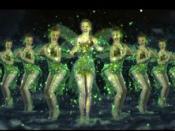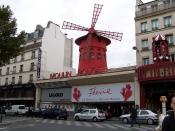Luhrmann uses many different techniques to create tension and impact in the Roxanne scene. The scene is already tense as it is a crisis moment in the film - Satine, the prostitute, must choose between breaking her true love Christian's heart and saving the Moulin Rouge by sleeping with the Duke, or losing the Moulin Rouge but not hurting Christian by not sleeping with the Duke. One of the techniques used to accentuate the tension is to split the scene between two different storylines, one containing Satine and the Duke in the Gothic Tower; the other set in the Moulin Rouge with many people. This gives the scene a quicker pace and allows Luhrmann to contrast the two settings effectively, creating a greater impact on the audience.
Another of the techniques Luhrmann uses to contrast the two settings is the use of lighting and colour in each setting, with the cool blue of the Gothic Tower juxtaposing the hot red of the Moulin Rouge. The Moulin Rouge is dark and shadowy with low-key lighting, which creates a secretive and perhaps seductive atmosphere. The light seems to be tinted red, which may symbolise Christian's anger, frustration at his and Satine's situation, and also his love for Satine. It could also be a link to the prostitute in the song, Roxanne, and her red light. As Christian moves outside during the scene, the tinted light effect leaves the Moulin Rouge and follows him, reinforcing this idea. By way of contrast, the Gothic Tower uses high-key lighting but the blue tint prevents the scene from being naturalistic. The unnatural blue lighting gives Satine an unhealthy, almost deathly look, perhaps exacerbated by the audience's knowledge of her illness, making the audience slightly tense. The blue filter used also suggests to the audience the...


